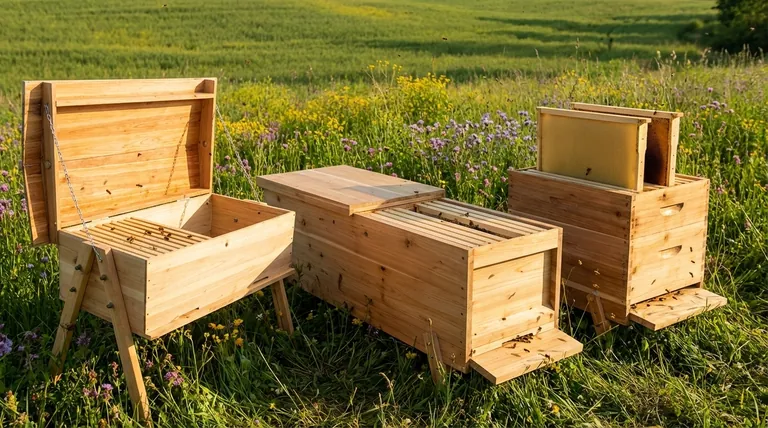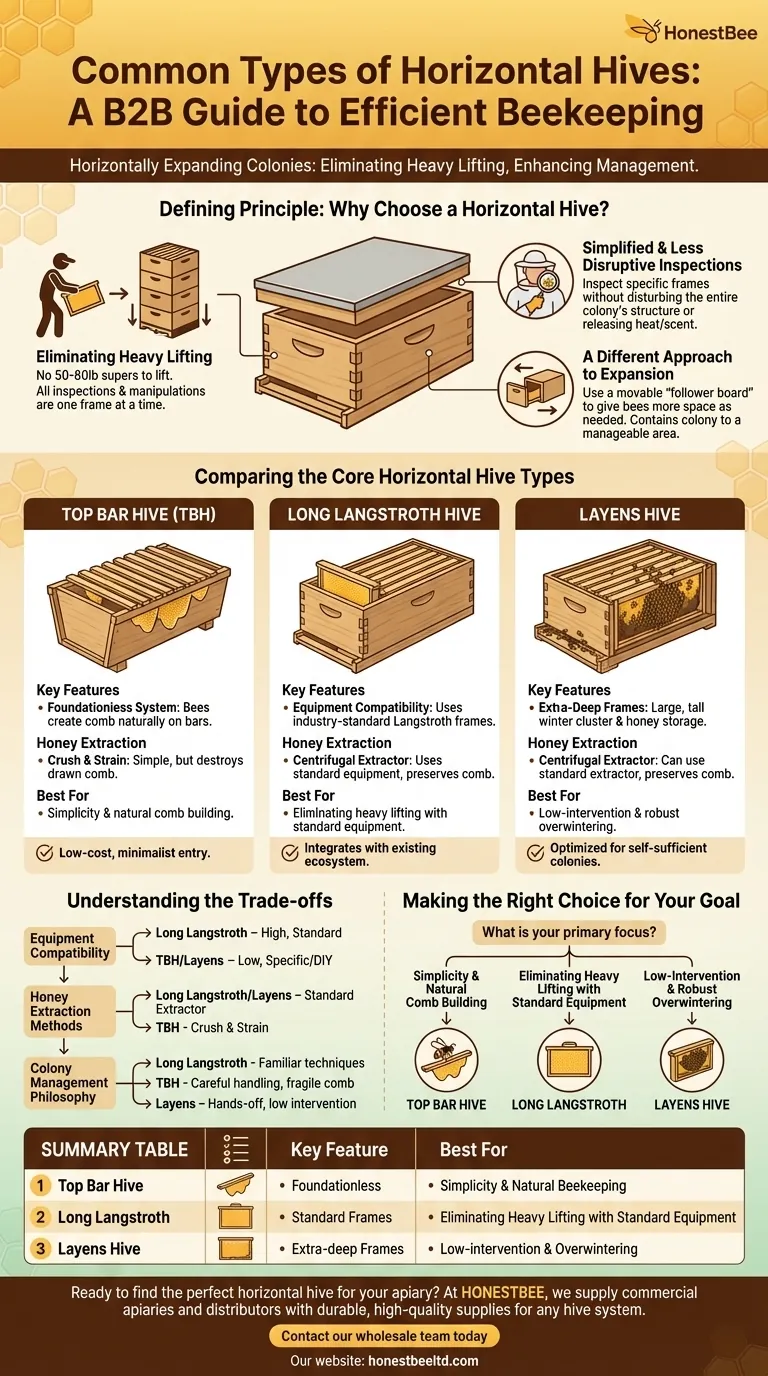In beekeeping, the common types of horizontal hives are the Top Bar hive, the Long Langstroth, and the Layens hive. Unlike traditional stacked hives, all of these designs allow the colony to expand sideways in a single long box, which eliminates the need for the beekeeper to lift heavy boxes full of honey.
The central decision between horizontal hives is not about which is "best," but about aligning the hive's design with your beekeeping goals. Your choice will determine your equipment compatibility, your management style, and how you harvest honey.

The Defining Principle: Why Choose a Horizontal Hive?
Horizontal hives are fundamentally different from the more common vertical Langstroth hives. They operate on a single level, which is their primary appeal and the source of their key benefits.
Eliminating Heavy Lifting
The most significant advantage is ergonomic. In a vertical hive, adding space or harvesting honey requires lifting "supers" that can weigh 50-80 pounds (23-36 kg). With a horizontal hive, all inspections and manipulations happen by removing one frame at a time, with no heavy lifting required.
Simplified and Less Disruptive Inspections
When you inspect a horizontal hive, you typically only disturb the specific frames you need to see. You do not have to "break" the hive into multiple boxes, disrupting the entire colony's structure and releasing significant heat and scent.
A Different Approach to Expansion
These hives use a "follower board," which is a solid panel that acts as a movable wall. To give the bees more space, you simply slide the follower board down and add new empty frames or bars. This contains the colony to a space they can manage and defend.
Comparing the Core Horizontal Hive Types
While they share the same horizontal principle, the three main types have distinct features and are suited to different beekeeping philosophies.
The Top Bar Hive (TBH)
A Top Bar Hive is the simplest design, often just a long, trough-shaped box with wooden bars resting across the top. The bees build their comb down from these bars naturally, without any frame or foundation.
This is a foundationless system, meaning you do not use pre-made sheets of wax or plastic. The bees create their comb entirely on their own, which many believe is more natural. Honey is typically harvested by cutting the comb off the bar and crushing it to strain out the honey.
The Long Langstroth Hive
This hive is exactly what it sounds like: a standard Langstroth hive body turned on its side. It is a single, long box built to hold standard Langstroth frames—typically deep-sized frames.
Its key advantage is equipment compatibility. If you already have Langstroth equipment or want to use the most common frame size in the industry, this is your hive. You can use standard wax or plastic foundations and extract honey with a centrifugal extractor, just as you would with a vertical hive.
The Layens Hive
Developed in France by Georges de Layens, this hive is very popular in Europe and is gaining traction in North America. It is a horizontal hive that uses its own unique, very deep frames.
These extra-deep frames allow the colony to form a large, tall winter cluster and store significant amounts of honey directly above the brood nest. The Layens system is often promoted for low-intervention, "natural" beekeeping, as the hive is designed to support the colony with minimal beekeeper input, especially through winter.
Understanding the Trade-offs
Choosing a horizontal hive involves trade-offs, primarily centered around compatibility and management style.
Equipment Compatibility
The Long Langstroth is the clear winner for compatibility, as it uses industry-standard frames. Top Bar and Layens hives operate as their own ecosystems. Sourcing frames, boxes, and other equipment for them can be more difficult or require DIY solutions.
Honey Extraction Methods
With a Long Langstroth or Layens hive, you can use a standard honey extractor because the comb is supported by a full frame. With a Top Bar hive, the comb is fragile and must be harvested via the "crush and strain" method, which is simpler but results in the loss of the drawn comb.
Colony Management Philosophy
The Long Langstroth allows a beekeeper to use familiar management techniques on a horizontal plane. The Top Bar hive requires more careful handling of fragile comb. The Layens hive is optimized for a hands-off approach, designed to let the bees manage their own resources with fewer inspections.
Making the Right Choice for Your Goal
Your choice should be guided by your physical needs, your desired level of involvement, and your access to equipment.
- If your primary focus is simplicity and natural comb building: The Top Bar Hive is a low-cost, minimalist entry into beekeeping that promotes the bees' own construction.
- If your primary focus is eliminating heavy lifting while using standard equipment: The Long Langstroth offers the perfect compromise, integrating with the most common beekeeping ecosystem.
- If your primary focus is low-intervention beekeeping and robust overwintering: The Layens hive, with its deep frames, is specifically designed for self-sufficient colonies that require less frequent management.
Ultimately, selecting a horizontal hive is about choosing a system that aligns with your personal beekeeping philosophy and physical capabilities.
Summary Table:
| Hive Type | Key Feature | Best For |
|---|---|---|
| Top Bar Hive (TBH) | Foundationless, natural comb building | Simplicity and natural beekeeping |
| Long Langstroth | Uses standard Langstroth frames | Eliminating heavy lifting with standard equipment |
| Layens Hive | Extra-deep frames for robust colonies | Low-intervention beekeeping and overwintering |
Ready to find the perfect horizontal hive for your apiary? At HONESTBEE, we supply commercial apiaries and beekeeping equipment distributors with the durable, high-quality supplies needed for any hive system—from Top Bar to Layens. Let our experts help you select the right equipment to enhance your operation's efficiency and honey production. Contact our wholesale team today to discuss your needs!
Visual Guide

Related Products
- Long Langstroth Style Horizontal Top Bar Hive for Wholesale
- Professional Hive Top Bee Feeder for Beekeeping
- HONESTBEE Professional Long Handled Hive Tool with Precision Cutting Blade
- Telescopic Beehive Outer Cover Lid Roof with Galvanised Sheeting for Langstroth Hive and Beehive Outer Cover
- HONESTBEE Round Hive Top Bee Feeder for Syrup
People Also Ask
- How does the top bar hive help control varroa mites? A Natural Approach to Mite Management
- What are the advantages of a top bar hive? Simpler, Bee-Centric Beekeeping for All
- What are the main differences between Langstroth hives and top bar hives? Choose the Right Hive for Your Beekeeping Goals
- What are the most popular types of hives besides the Langstroth? Top Bar & Horizontal Hives Explained
- What is a top bar bee hive? A Natural, Low-Stress Beekeeping Solution



















